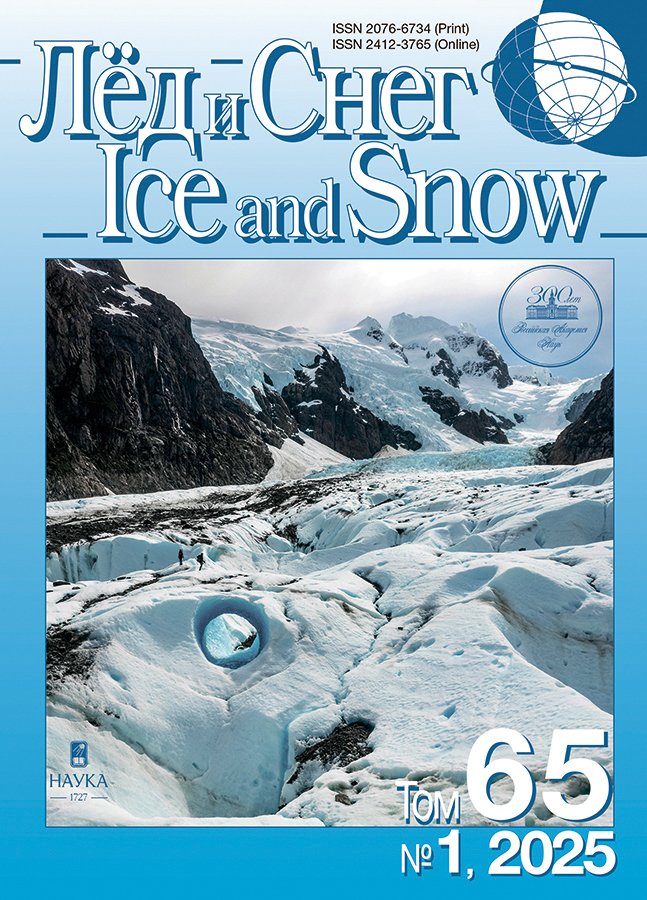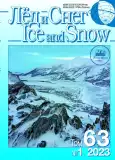Ice and Snow Thickness of the IGAN Glacier in the Polar Urals from Ground-Based Radio-Echo Sounding 2019 and 2021
- Authors: Lavrentiev I.I.1, Nosenko G.A.1, Glazovsky A.F.1, Shein A.N.2, Ivanov M.N.3, Leopold Y.K.2
-
Affiliations:
- Institute of Geography, Russian Academy of Sciences
- “Scientific Center for the Study of the Arctic”
- Lomonosov Moscow State University
- Issue: Vol 63, No 1 (2023)
- Pages: 5-16
- Section: Glaciers and ice sheets
- URL: https://journals.rcsi.science/2076-6734/article/view/137457
- DOI: https://doi.org/10.31857/S2076673423010106
- EDN: https://elibrary.ru/MAEUJG
- ID: 137457
Cite item
Full Text
Abstract
Small glaciers of the Polar Urals are at the limits of their existence. Their state and changes serve as an important natural indicator of modern climatic changes. In 2019 and 2021, we performed ground-based radar studies of one of these glaciers, the IGAN Glacier, to measure ice thickness and snow cover. We used Picor-Led (1600 MHz), and VIRL–7 (20 MHz) GPRs. According to these data, the glacier has an average thickness of 49 m, maximum 114 m. The glacier has a polythermal structure: a cold ice layer with an average thickness of 12 m (maximum 43 m), overlaps the temperate ice with an average thickness of 37 m (maximum 114 m in the upper part of the glacier). The volume of ice contained in the glacier (in its studied part) is 14.3 × 106 m3, of which 10.89 × 106 m3 is temperate ice and 3.44 × 106 m3 is cold ice. For comparison: according to the radar data of 1968, the total ice thickness then reached 150 m in the central part, and the thickness of the upper layer of cold ice was 40–50 m. Radar snow gauge survey allowed to build schemes of seasonal snow thickness distribution over the glacier surface in 2019 and 2021, where there is a general spatial pattern of snow thickness growth from 2 m on the glacier terminus to 8 m or more to the rear wall of the corrie, which is due to the significant influence of avalanche feeding and wind transport. The glacier has lost about 3.2 × 106 m3 of ice per last decade, if the rate of loss continues, it may disappear in 40–50 years. However, this process may have a non-linear nature, as it involves not only climatic factors, but also local terrain features, on the one hand contributing to a high accumulation of snow, on the other – the formation of a glacial lake during glacier retreat, which may increase ablation.
About the authors
I. I. Lavrentiev
Institute of Geography, Russian Academy of Sciences
Author for correspondence.
Email: lavrentiev@igras.ru
Russia, Moscow
G. A. Nosenko
Institute of Geography, Russian Academy of Sciences
Email: lavrentiev@igras.ru
Russia, Moscow
A. F. Glazovsky
Institute of Geography, Russian Academy of Sciences
Email: lavrentiev@igras.ru
Russia, Moscow
A. N. Shein
“Scientific Center for the Study of the Arctic”
Email: lavrentiev@igras.ru
Russia, Salekhard
M. N. Ivanov
Lomonosov Moscow State University
Email: lavrentiev@igras.ru
Russia, Moscow
Ya. K. Leopold
“Scientific Center for the Study of the Arctic”
Email: lavrentiev@igras.ru
Russia, Salekhard
References
- Borovinskiy B.A. Geophysical studies of glaciers in the Polar Urals. Materialy Glyatsiologicheskikh Issledovaniy. Data of Glaciological Studies. 1964, 9: 227–230 [In Russian].
- Voloshina A.P. Some results of studies of the mass balance of the Polar Urals glaciers. Materialy Glyatsiologicheskikh Issledovaniy. Data of Glaciological Studies. 1988. 61: 44–51 [In Russian].
- Katalog lednikov SSSR. USSR Glacier Inventory. V. 3. Northern Edge. Is. 3 Ural. Leningrad: Hydrometeoizdat, 1966: 52 p. [In Russian].
- Kulnitsky L.M., Gofman P.A., Tokarev M.Y. Mathematical processing of georadar data and RADEXPRO system. Razvedka i okhrana nedr. Exploration and protection of mineral resources. 2001, 3: 6–11 [In Russian].
- Macheret Y.Y. Radiozondirovanie lednikov. Radio echo-sounding of glaciers. Moscow: Nauchny Mir, 2006: 392 p. [In Russian].
- Macheret Yu.Ya. Primenenie geofizicheskih metodov dlya izucheniya moshchnosti l’da i stroeniya gornyh lednikov. Application of geophysical methods to study ice thickness and structure of mountain glaciers. PhD. Dissertatsiya na soiskaniye uchenoy stepeni kandidata tekhnicheskih nauk. Moscow, Moscow State University, 1974: 174 p. [In Russian].
- Nosenko G.A., Muraviev A.Y., Ivanov M.N., Sinitsky A.I., Kobelev V.O., Nikitin S.A. Response of the Polar Urals glaciers to the modern climate changes. Led I Sneg. Ice and Snow. 2020, 60 (1): 42–57 [In Russian]. https://doi.org/10.31857/S2076673420010022
- Troitsky L.S., Khodakov V.G., Mikhalev V.I., Guskov A.S., Lebedeva I.M., Adamenko V.N., Zhivkovich L.A. Oledenenie Urala. The glaciation of the Urals. Moscow: Nauka, 1966: 355 p. [In Russian].
- Tsvetkov D.G. 10 years of photogeodetic works on the glaciers of the Polar Urals (Experience of land surveying and mapping of small glaciers with the application of topograps of the IGAN and Obruchev glaciers at a scale of 1:5000). Materialy Glyatsiologicheskikh Issledovaniy. Data of Glaciological Studies. 1970, 16: 245–257 [In Russian].
- Debeer C.M., Sharp M.J. Topographic influences on recent changes of very small glaciers in the Monashee Mountains, British Columbia, Canada. Journ. of Glaciology. 2009, 55 (192): 691–700. https://doi.org/10.3189/002214309789470851.
- ECMWF ERA5 (0.5 × 0.5 deg): https://climatereanalyzer.org/reanalysis/monthly_tseries. (Last access: 01 June 2022).
- Farinotti, D., Huss M., Fürst J.J., Landmann J., Machguth H., Maussion F., Pandit A. A consensus, estimate for the ice thickness distribution of all glaciers on Earth. Nature Geosciences. 2019, 12: 168–173. https://doi.org/10.1038/s41561-019-0300-3
- Farinotti D. and the ITMIX Consortium. How accurate are estimates of glacier ice thickness? Results from ITMIX, the Ice Thickness Models Intercomparison experiment. The Cryosphere. 2017, 11: 949–970. https://doi.org/10.5194/tc-11-949-2017.
- Fischer M., Huss M., Kummert M., Hoelzle M. Application and validation of long-range terrestrial laser scanning to monitor the mass balance of very small glaciers in the Swiss Alps. The Cryosphere. 2016, 10: 1279–1295. https://doi.org/10.5194/tc-10-1279-2016.
- GISS Surface Temperature Analysis (v4)/Station Data: Salekhard (66.5294N, 66.5294E): https://data.giss.nasa.gov/tmp/gistemp/STATIONS/tmp_RSM00023330_14_0_1/station.txt. (Last access: 01 June 2022).
- Oerlemans J., Anderson B., Hubbard A., Huybrechts Ph., Johannesson T., Knap W.H., Schmeits M., Stroeven A.P., van de Wal R.S.W., Wallinga J., Zuo Z. Modelling the response of glaciers to climate warming. Climate Dynamic. 1998, 14 (4): 267–274.
- Paul F., Rastner P., Azzoni R.S., Diolaiuti G., Fugazza D., Le Bris R., Nemec J., Rabatel A., Ramusovic M., Schwaizer G., Smiraglia C. Glacier shrinkage in the Alps continues unabated as revealed by a new glacier inventory from Sentinel-2. Earth Syst. Science Data. 2020, 12: 1805–1821. https://doi.org/10.5194/essd-12-1805-2020.
- Prinz R., Heller A., Ladne M., Nicholson L.I., Kaser G. Mapping the Loss of Mt. Kenya’s Glaciers: An Example of the Challenges of Satellite Monitoring of Very Small Glaciers. Journ. of Geosciences. 2018, 8 (5): 174–188. https://doi.org/10.3390/geosciences8050174.
- Pfeffer W.T., Arendt A.A., Bliss A., Bolch T., Cogley J.G., Gardner A.S., and the Randolph Consortium. The Randolph Glacier Inventory: a globally complete inventory of glaciers // Journ. of Glaciology. 2014, 60: 537–552. https://doi.org/10.3189/2014JoG13J176.
- Rabatel A., Francou B., Soruco A., Gomez J., Cáceres B., Ceballos J.L., Basantes R., Vuille M., Sicart J.‑E., Huggel C., Scheel M., Lejeune Y., Arnaud Y., Collet M., Condom T., Consoli G., Favier V., Jomelli V., Galarraga R., Ginot P., Maisincho L., Mendoza J., Ménégoz M., Ramirez E., Ribstein P., Suarez W., Villacis M., Wagnon P. Current state of glaciers in the tropical Andes: a multi-century perspective on glacier evolution and climate change. The Cryosphere. 2013, 7: 81–102. https://doi.org/10.5194/tc-7-81-2013.
- Shahgedanova M., Nosenko G., Bushueva I., Ivanov M. Changes in area and geodetic mass balance of small glaciers, Polar Urals, Russia 1950–2008. Journ. Of Glaciology. 2017, 58 (211): 953–964. https://doi.org/10.3189/2012JoG11J233.
- Tielidze L., Nosenko G., Khromova T., Paul F. Strong acceleration of glacier area loss in the Greater Caucasus between 2000 and 2020. The Cryosphere. 2022, 16: 489–504. https://doi.org/10.5194/tc-16-489-2022.
- Vasilenko E.V., Machio F., Lapazaran J.J., Navarro F.J., Frolovskiy K. A compact lightweight multipurpose ground-penetrating radar for glaciological applications. Journ. of Glaciology. 2011, 57: 1113–1118. https://doi.org/10.3189/002214311798843430.
- Zemp M., Nussbaumer S.U., Gärtner-Roer I., Bannwart J., Paul, F., Hoelzle, M. WGMS 2021. Global Glacier Change Bulletin No. 4 (2018–2019). ISC(WDS)/IUGG(IACS)/UNEP/UNESCO/WMO, World Glacier Monitoring Service. Zurich- Switzerland. 2021, 278 p. https://doi.org/10.5904/wgms-fog-2021-05.
Supplementary files















